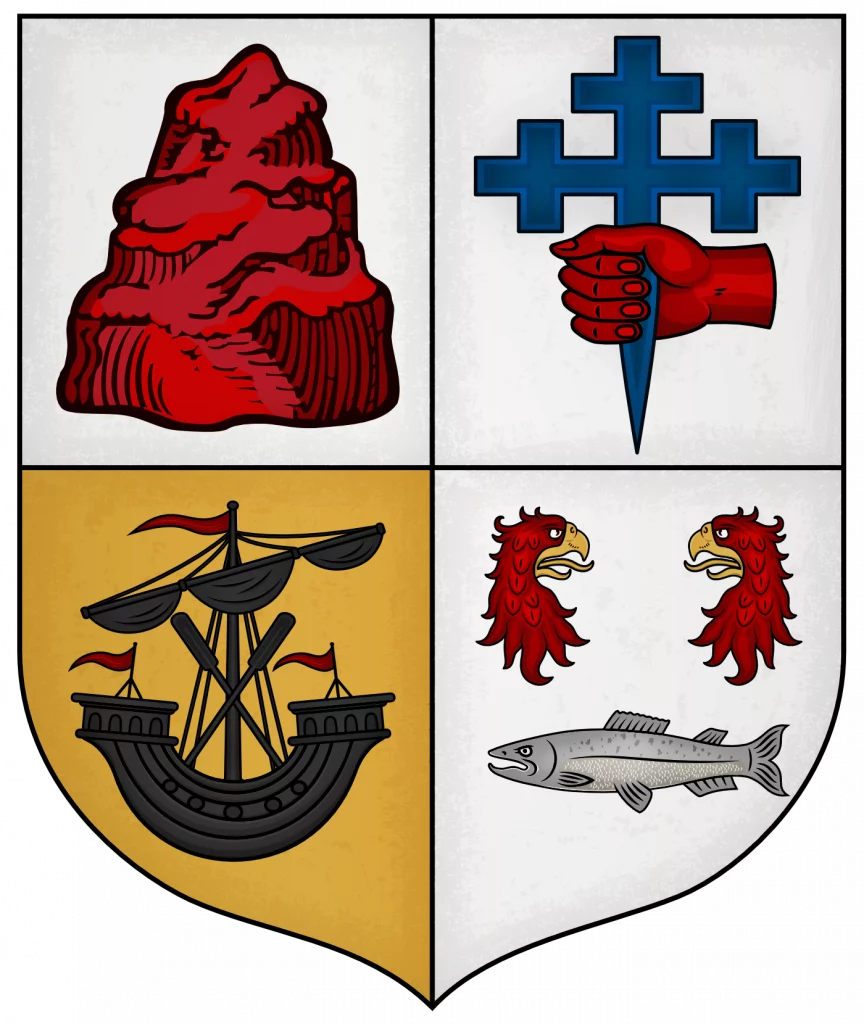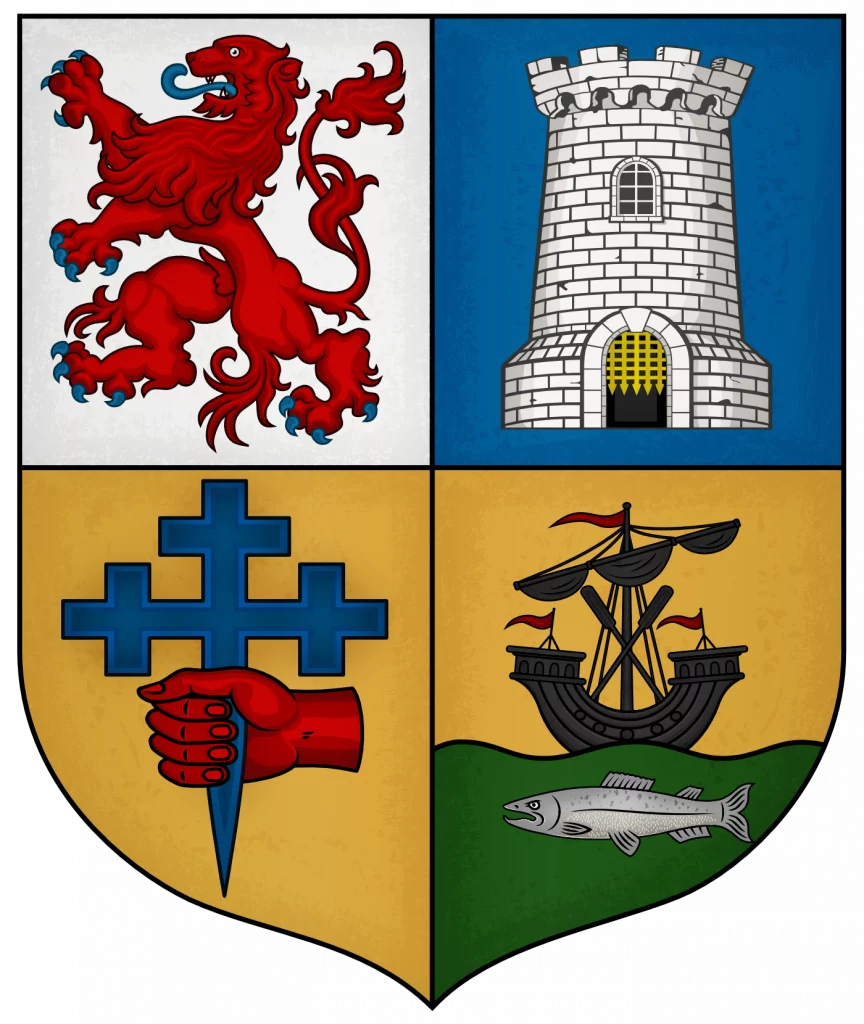The House of Duart is primary branch and thus chiefly line the Clan Maclean; it takes its name from the clan seat, Duart Castle.
History
The primary branch was likely established in 13451 when John Dubh sent his sons, Lachlan Lùbanach and Hector Reaganach, to negotiate with John of Islay, 1st Lord of the Isles, for land on the Isle of Mull. The negotiation failed and the brothers abducted John of Islay. To their surprise, after his release John rewarded them for their boldness, which he wished to leverage, and granted each lands on Mull.

Lachlan was also granted titles and office both to John of Islay’s personal household and the Lordship of the Isles itself,6 including Chamberlain of the household, the office of Lieutenant-General of the Isles,2 and the honor of the “right hand of all Clans in Battle,”1 Receiving estate charters from John of Islay effected two important things. First it made the brothers the first Macleans to be heads of estates, and thus established the first two houses. Second, It shifted the fealty of the brothers to to the Lordship of the Isles, where it would remain for more than a century.
By 1367, Lachlan was betrothed to the Lord of the Isles’ daughter, Mary Macdonald; Duart Castle, its estate, and several territories were included in the dowry.3 As Mary was also the grand-daughter of Robert II, King of Scots,4 the marriage established bonds with both the semi-independent Lordship of the Isles and the geography distant Kingdom of Scotland. The later would become more important in time.
All accounts of the early Macleans consistently describe Lachlan’s preeminence, from this is reasonable to infer that he was the Maclean Tanist while his father, John Dubh, was the Chief; thus through Lachlan the chiefly line descended. The tanist was the heir apparent chosen from the sons of the chief by consensus of the clan’s leaders7 and was the system governing inheritance until a court ruling in 1608 replaced it with primogeniture.8 John of Islay’s generosity toward Lachlan fits the assertion, in that that he appeared to believe he was gaining the loyalty of the future Maclean Chief.
The House of Duart remained loyal to the Lordship of the Isles, and Lachlan’s descendants served on the Council of the Isles until it was forfeit James IV of Scotland in 1493.5 Thereafter, the House of Duart remained loyal to Stewart Kings through the Jacobite Risings and to the Battle of Culloden in 1746.
Since 1630 the Houses of Duart and Morvern have been coheritable; following the death of Sir Lachlan, the younger son of Sir Hector Óg, 15th of Duart, who was created 1st Baronet of Morvern and became chief after the death of his elder brother, Sir Hector Mor, 16th of Duart.10
During the Jacobite Uprisings, the Duart Chiefs also dealt with the Clan Campbell’s play to take Maclean territories. Though outstanding on the battlefield, the Maclean Chiefs had not mastered the art of political manipulation and did not carry the influence at court necessary to ward off the Campbell’s political gamesmanship for their territory. Following the Uprising of 1715 the territories of the Duart Chiefs were lost, including Duart Castle itself to the deceitful dealings of the Campbell Chief and the use of friendship of government officials.
Following the ’15, Sir John (20th Chief) joined the exiled Stewart court in Rome. The Chiefs remained in exile until Sir Hector (21st Chief) died in Rome without heir in 1750. The chiefship fell to Allan of Brolas, the House of Brolas merged into the House of Duart.
In 1911, Colonel Sir Fitzroy Donald Maclean (26th Chief) reclaimed Duart Castle 221 years after the Chief’s banner last flew over the ancient stronghold. In 1932, and on his 100th birthday, Sir Fitzroy accepted a truce from the Campbell Chief, ending the feud between the two clans that had existed for nearly two and a half centuries; milestone was covered by Times Magazine.
The Chiefs of the Clan Maclean have mostly continued in the ancient military traditions of their forebears, serving as officers in most of the wars of the nineteenth and twentieth centuries. The House of Duart has been at the forefront of keeping the connection, history, and kinship alive in the modern era by restoring Duart Castle, establishing the Heritage Trust, and inviting the Children of Gilleain to once again regularly gather at the their ancient home.
Duart Estate
Senior Cadet Branch Clans
Branch clans meet the criteria for cadetcy, yet are feudally independent as they hold charters directly from the sovereign, rather than from their Chief. The cadet houses of Lochbuie and Ardgour are recognized by the Lord Lyon as feudally independent clans; as are the McLeans of Coll, though they have been armigerous since 1882 when the heritable line ended.

House of Ardgour
2nd Senior Cadet of Duart
Clan Maclean of Ardgour
House of Coll
3rd Sr Cadet of Duart
Clan McLean of Coll
Senior Cadet Branches
The cadet branches are distinct hereditary houses that trace their genealogy to the primary branch of the clan. Senior cadet branches are all descended from Iain Dubh (4th Chief) and thus back to Gilleain na Tuaighe, 1st Chief; junior cadet branches can trace their lineage back to a senior cadet branch.9
House of
Lehir & Ross
4th Senior Cadet Branch
House of
Morvern
5th Senior Cadet Branch
House of
Torloisk
6th Senior Cadet Branch
House of
Makeléer
7th Senior Cadet Branch
Lords of Gåsevadholm, Hageby and Hammarö
Baronets of Duart (Sweden)
House of Dunconnel
8th Senior Cadet Branch

